Text: Mindaugas Gapševi?ius
I love the fact that human genomes can be found in only about 10 percent of all the cells that occupy the mundane space I call my body; the other 90 percent of the cells are filled with the genomes of bacteria, fungi, protists, and such, some of which play in a symphony necessary to my being alive at all, and some of which are hitching a ride and doing the rest of me, of us, no harm.
— Donna Haraway
ABSTRACT
This paper is part of a broader body of research on creativity in human-machine systems and a performative/participative/educative/interactive installation within the Introduction to Posthuman Aesthetics project(1), initiated in 2016. The discourse introduced in the paper and the Toolkit invite the reader and Toolkit user to think about symbiotic relationships between human and non-human organisms. The paper is organized into three parts. The first part presents the idea of symbiotic relationships among organisms, the second part is a short compilation of related artistic projects, and the last section introduces the Toolkit, an artistic and educative set of tools and ingredients for practicing collaborative work with a symbiotic colony of bacteria and yeast (SCOBY). The collaborative work is introduced via two workshops: In the first case, bacterial paper is produced from dried SCOBY, and, in the second, cellulose is grown from the isolated Gluconacetobacter, which, if processed further, becomes an alternative to the plant cellulose normally used for paper production.
SYMBIOTIC RELATIONSHIPS
This paper refers mainly to three different kinds of research: a theory of the origin of eukaryotic cells proposed by Lynn Margulis, formerly Lynn Sagan (Sagan, 1966), the Human Microbiome Project carried out by the National Institutes of Health in the United States (NIH, 2012), and a manifesto-like proposal of interspecies dependencies by Donna Haraway (2008).
While introducing the companion species idea, Donna Haraway talks about her sheepdog Ms. Cayenne Pepper, with whom Haraway shared interactions, exchanging, for example, saliva and, along with it, genes and bacteria, making them part of herself. In so doing, Haraway asked “who ‘we’ will become when species meet” and proposes the uniqueness of an organism being shaped via the processes of various interactions with different species. The discourse here goes far beyond a traditional, let’s say Cartesian (Cogito ergo sum) or Nietzschean (the Übermensch) understanding of the human, wherein the former defines human existence by the ability to think and the latter defines the human as striving to overcome their own limitations. In Haraway’s case, the human is defined by collaboration with other species. This idea has been developed by Haraway while referring to evolutionary theorist Lynn Margulis, and research on human microbiota being carried out by the National Institutes of Health.
Being an evolutionary theorist, Lynn Margulis criticized the traditionally accepted theory of evolution proposed by Charles Darwin. She introduced evolution as merely collaborative interaction rather than the struggle for existence. If the struggle for existence in Darwin’s theory led to natural selection and survival of the fittest (Darwin, 1859), Margulis introduced a theory of symbiotic organisms wherein, through interaction and collaboration, prokaryotic organisms evolved into more complex eukaryotic cells (Sagan, 1966). In her article ”On the Origin of Mitosing Cells,” the theory is introduced through the interaction of three ancient organelles: the mitochondria, the photosynthetic plastids, and the flagella, which, over the course of changing weather conditions in Earth’s history, were impelled to mutate into one organism. This process was possible due to vapor and the escape of free hydrogen into the upper atmosphere, which led to the production of molecular oxygen. The increasing amount of oxygen, in turn, was consumed by other organisms that had to survive in the changing conditions: An aerobic prokaryotic mitochondrion was ingested into the cytoplasm of a heterotrophic anaerobe, while symbiotic cilium attached to other bacteria and formed a flagellum. Further evolution resulted in eukaryotic blue-green algae:
“During the course of the evolution of mitosis, photosynthetic plastids (themselves derived from prokaryotes) were symbiotically acquired by some of these protozoans to form the eukaryotic algae and the green plants” (Margulis, 1966:225).
The idea of evolutionary change via interacting organisms suggests that we humans are not humans because we “think,” but because we interact with other organisms and we evolve with other organisms. Therefore, the discourse opens up for awareness of whom we interact with and how we interact. This awareness brings us closer to acknowledging symbiotic processes within and around other organisms.
The National Institutes of Health carried out a project analyzing and sequencing the variety of DNA in the human body, coming to the conclusion that the ratio of human cells with other cells within the body is one to ten. The cells belonging to humans have one DNA strand and other organisms have the other. Those other organisms carrying different DNA are various fungi, bacteria, and protists that live on the skin, in the guts, or in the nose:
”Microbes inhabit just about every part of the human body, living on the skin, in the gut, and up the nose. Sometimes they cause sickness, but most of the time, microorganisms live in harmony with their human hosts, providing vital functions essential for human survival.” (NIH, 2012)
To define the human microbiome, researchers analyzed 242 people by taking samples from different parts of body and analyzing them with DNA sequencing machines instead of by growing microorganisms in a medium under laboratory conditions; this way, they ended up with more accurate results. It follows that these more than 10,000 other microbial species occupying the human ecosystem must have a function that is more than just lurking around the body and consuming energy provided by digested food. Microorganisms break down proteins, lipids, and carbohydrates, making them ready to be absorbed by the human organism. They also produce vitamins and anti-inflammatories that regulate the immune system and keep the human body safe from diseases (NIH, 2012). In short, microorganisms have been collaborating with humans for survival over the course of the evolution.
So, what is crucial is the initial interaction between all organisms, including the smallest and the biggest: bacteria, fungi, protists, plants, animals. Some of them produce oxygen and some consume it, some of them break down compounds and some absorb broken down chemical elements. Everything is in constant interaction and symbiotic relationships, including living organisms, chemical compounds, and inorganic elements.
RELATED ARTWORKS
Symbiotic relationships between organisms is one of the discourses in contemporary aesthetics and interdisciplinary practices, especially those dealing with BioArt and biohacking, both of which often include DIY methods and work with living organisms. Introduced below are four projects covering the discourse related to symbiosis and symbiotic relationships.
Nurit Bar-Shai, Objectivity [tentative]: Soundscapes (2)
The artwork (2012—2013) contains a number of petri dishes hung on the wall, in all, shaping horizontal and vertical lines. Petri dishes are inoculated with dyed bacteria (Paenibacilus vortex), which are grown on an agar medium with necessary nutrients. In his book Bio Design (2012), Willem Myers described the artwork in the following:
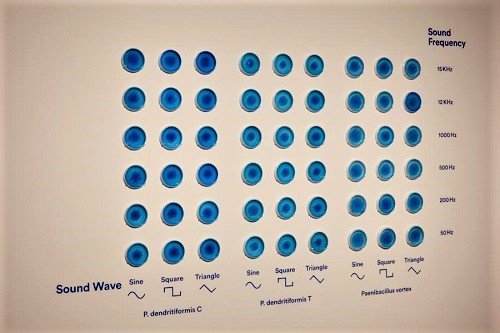 Nurit Bar-Shai, “Objectivity [tentative]: Soundscapes” (2012–2013),
Nurit Bar-Shai, “Objectivity [tentative]: Soundscapes” (2012–2013),
in “Exo-Evolution,” ZKM 2015 / © Foto: ZKM | Zentrum
für Kunst und Medientechnologie. Photo: Jonas Zilius.“In visualizing biological systems of self-organization, it is possible to detect surprising complexity and to achieve dramatically varied results with only slight alterations in the initial environment. (…) These pieces examine the decision making of living, performative objects that ‘grow images’ as a sculptural form. (…) These microorganisms possess advanced social motility, employing cell-to-cell signaling to prompt activities such as attraction and repulsion under different environmental conditions. (…) Once the bacteria have grown into patterns, prompted by the dispersal of nutrients, they are made visible with dye that also halts their growth” (Myers, 2012).
The work brings up the context of self-organization and collaboration between bacteria in Paenibacilus vortex bacterial colonies. The discourse introduced could be expanded to networks of bacteria sending signals from cell to cell while searching for food. The artwork also introduces the bacterial species as “intelligent” through their ability to draw fractal-like patterns.
Tarsh Bates, The Unsettling Eros of Contact Zones (3)
In the exhibition description (2015), the artist wrote:
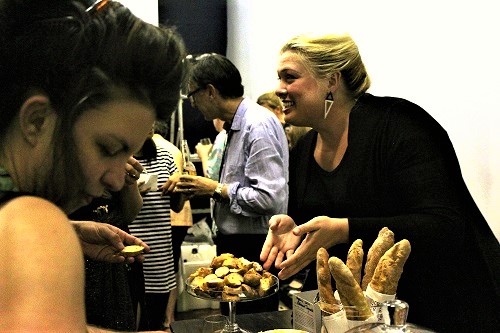 Tarsh Bates’ exhibition “The Unsettling Eros of Contact Zones” at
Tarsh Bates’ exhibition “The Unsettling Eros of Contact Zones” at
the Gallery Central Shopfront, 2015. Photo: Megan Schlipalius.An exhibition exploring what it means to be human when we recognise our bodies as multi-species ecologies, with a particular focus on the relationships between Homo sapiens and Candida albicans. I used scientific and artistic methodologies to explore physical, emotional, cultural and political relationships between humans and Candida. Works comprised sculptural, photographic and filmic works, dead and living organisms, and were developed during my PhD research at SymbioticA and the University of Western Australia. (https://tarshbates.com/portfolio/the-unsettling-eros-of-contact-zones-and-other-stories-2015/)
The installation uses a variety of materials, including organic artisanal white bread leavened with Candida albicans and Saccharomyces cerevisiae yeast strains, brie, blue cheese, and hummus. During the event, the public is invited to taste bread baked with traditional yeast and yeast that normally lives in human bodies.
Besides the discourse on symbiotic relationships between yeast and humans, Bates also raises ethical questions regarding the consumption of organisms, especially those living in close relationships with humans. It also questions borders between organisms of similar bacterial strains: If we consume bread without questioning the presence of the Saccharomyces cerevisiae strain, why is it so unpleasant to eat bread with Candida albicans, another similar bacterial strain that lives in our bodies?
Christina Agapakis and Sissel Tolaas, Selfmade (4)
The Selfmade project was part of a larger exhibition in Dublin Science Gallery in 2013, curated by artist and designer Alexandra Daisy Ginsberg, Anthony Dunne (Royal College of Art), Paul Freemont (Imperial College), Cathal Garvey (bio-hacker), and Michael John Gorman (Science Gallery).
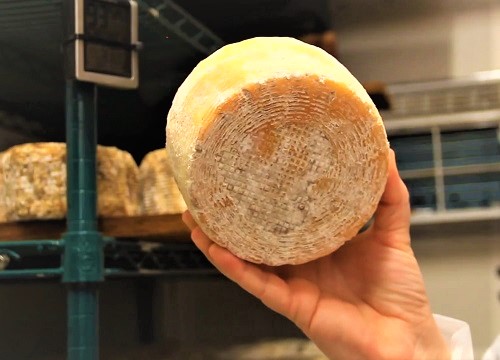 Cheese made from human toe bacteria. Image: http://cultofweird.comScientist Christina Agapakis (US) and scent expert Sissel Tolaas (NO) collected bacteria from nose, tears, and other parts of different bodies in order to produce cheese. The artists described their project as follows:
Cheese made from human toe bacteria. Image: http://cultofweird.comScientist Christina Agapakis (US) and scent expert Sissel Tolaas (NO) collected bacteria from nose, tears, and other parts of different bodies in order to produce cheese. The artists described their project as follows:
Selfmade is a series of ‘microbial sketches’, portraits reflecting an individual’s microbial landscape in a unique cheese. Each cheese is crafted from starter cultures sampled from the skin of a different person. Isolated microbial strains were identified and characterised using microbiological techniques and 16S ribosomal RNA sequencing. Like the human body, each cheese has a unique set of microbes that metabolically shape a unique odour. Cheese odours were sampled and characterised using headspace gas chromatography-mass spectrometry analysis, a technique used to identify and/or quantify volatile organic compounds present in a sample. (5)
The idea behind the project goes back into hundreds and thousands years of history, when microorganisms from human bodies accidentally appeared in milk and milk products and fermented and hardened them into what we now know as cheese. Although symbiotic relationships between microorganisms are directly present in cheese production, cheese would not have become cheese without microorganisms living on and inside the human body.
François-Joseph Lapointe, 1000 Handshakes (6)
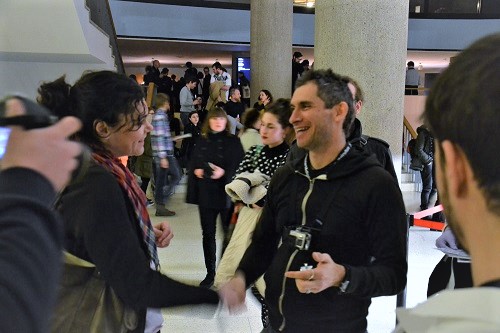 1000 Handshakes at the Transmediale Festival in Berlin, 2016.
1000 Handshakes at the Transmediale Festival in Berlin, 2016.
Photo: Art Laboratory Berlin1000 Handshakes was performed for the first time at the Panum Institute, University of Copenhagen, in 2014. Later the same year, it was repeated at the Medical Museion in Copenhagen, as well as during the Transmediale festival for media art and digital culture in Berlin (2016). For his performance, biologist and bioartist François-Joseph Lapointe from Montreal shook hands with 1000 people. Also being a scientist, Lapointe approached his work from a scientific research perspective as well, collecting bacterial samples from his hands and analyzing them in the laboratory. The result – visualized networks of bacterial species – were presented at the Art Laboratory Berlin gallery in 2016 within a larger series of exhibitions entitled Non Human Subjectivities.
According to Art Laboratory Berlin, “The performance raises awareness through physical and social engagement, through acts of participation and exchange on social, individual and microbial levels. The handshake, a basic and ancient act of networking forms the beginning of a social, scientific and artistic collaboration between the performer and the public.” It also extends the discourse on relationships between humans and bacteria into the symbiotic social network, adding an additional discourse of shared human and non-human networks.
TOOLKIT
The Toolkit has been designed in order to discuss symbiotic relations between organisms and to develop an awareness of interspecies dependency with participants. The Toolkit includes jars with chemical elements and ingredients, along with a sample of SCOBY within the Kombucha tea. It also has a set of necessary tools for trying to make bacterial cellulose in a practical way, including scales and a microscope.
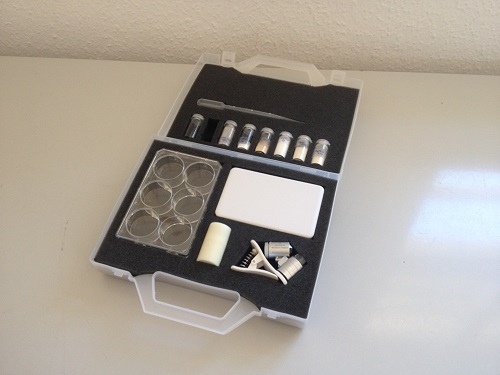 Toolkit for introducing symbiotic relationships between organisms.To introduce symbiotic relationships between organisms, I use SCOBY, a symbiotic colony of bacteria and yeast. The colony refers to mixed cultures of bacteria and yeast present during the fermentation process within the tea. The DNA sequencing analysis of the bacterial and fungal populations of five distinct SCOBY resulted in a number of Acetobacter and Saccharomyces species, or more specifically: Gluconacetobacter (in some papers, also referred to as Komagataeibacter or Acetobacter) was present in more than 85% of all samples, Lactobacillus was present in up to 30% of the samples analyzed, Zygosaccharomyces was present in more than 95% of the kombucha tea, and Acetobacter was detected in less than 2% of samples. A great variety of other microbial bacteria and yeasts, including candida, Saccharomyces, and Saccharomycoides, was also present (Marsh et al., 2013).
Toolkit for introducing symbiotic relationships between organisms.To introduce symbiotic relationships between organisms, I use SCOBY, a symbiotic colony of bacteria and yeast. The colony refers to mixed cultures of bacteria and yeast present during the fermentation process within the tea. The DNA sequencing analysis of the bacterial and fungal populations of five distinct SCOBY resulted in a number of Acetobacter and Saccharomyces species, or more specifically: Gluconacetobacter (in some papers, also referred to as Komagataeibacter or Acetobacter) was present in more than 85% of all samples, Lactobacillus was present in up to 30% of the samples analyzed, Zygosaccharomyces was present in more than 95% of the kombucha tea, and Acetobacter was detected in less than 2% of samples. A great variety of other microbial bacteria and yeasts, including candida, Saccharomyces, and Saccharomycoides, was also present (Marsh et al., 2013).
Within the two workshops introduced, I show how to grow bacterial cellulose. This project could be seen as useful from the perspective of contemporary discourses, learning purposes, interdisciplinary practices, and consumption. Contemporary discourses, including those developed by Donna Haraway, have been introduced in the previous section on symbiotic relations. While learning is pursued through DIY practice and the use of the Toolkit, the interdisciplinary nature of this project is comprised of this paper, the referenced theory around symbiotic relations, references to artistic projects, and finally the Toolkit itself as an aesthetic object and a learning tool. The workshops could also be useful from the perspective of consumption, because the growth of SCOBY produces a fermented tea to be imbibed as a beverage or, if left for a longer term of fermentation, vinegar that is ready to be added as an ingredient to meals.
The first workshop introduces the growth of the SCOBY, which, if dried out, could be used directly as paper. The other workshop introduces the isolation of Gluconacetobacter xylinus from the SCOBY culture, which, in turn, could be further used for the production of cellulose. In both cases, users of the Toolkit are introduced to bacterial cellulose, which differs in structure from the traditional plant cellulose, used for paper, paperboard, or cellophane production. In addition, the second workshop teaches participants how to isolate microbial species from symbiotic cultures, which could also be interesting for further research and analysis of living organisms (as for example, envisioning the evolutionary theory proposed by Lynn Margulis), especially for those individuals with no prior experience working with microorganisms.
Workshop 1. SCOBY and Kombucha Tea
To prepare ?100 ml of liquid to grow SCOBY and to also brew kombucha tea, add the following:
SCOBY with kombucha tea – 5 ml
Glucose or sugar – 5 g
Green or black tea – one teaspoon of loose tea or one tea bag
Clean cheese cloth or coffee filter
A jar or a glass/plastic container – 100 ml or bigger
A sheet of baking paper (for drying SCOBY)
Growing SCOBY is a simple process that requires a minimal amount of time. The aim of the project is twofold: to grow SCOBY and to brew kombucha tea. While the SCOBY grown could be used to produce matter similar to paper, sometimes called simply ”bacterial cellulose paper”, the kombucha tea can be consumed.
To prepare the medium, tap water needs to be boiled in order to kill additional microorganisms and to more easily dissolve the added sugar or glucose. If by chance there is no way to heat up the water, you can use room-temperature water – in that case, the glucose or sugar might take more time to dissolve and microorganisms could contaminate the SCOBY. You do not need to dissolve the sweetener completely, as it will fully dissolve eventually.
Add a tea bag or loose tea in a tea ball. Leave it in for at least 10 minutes to steep. If heated, allow the tea solution to cool to room temperature before adding the kombucha cultures (the SCOBY with brewed tea).
It will take 2-3 days to see the start of the formation of the new SCOBY. It appears as a translucent jelly-type pellicle forming on the surface of the tea solution. After around 10 days, your SCOBY on top of the tea should reach 3-5 mm in thickness, and it will be ready to either dry for bacterial cellulose paper or continue to grow a new layer of pellicle. At the same time, the brewed kombucha tea should be ready to drink.
You may want to first taste if your kombucha tea is ready for consumption. If using pH test strips, the pH reading should be between 2.5 and 3.2. This range tells us that the organic acids, pro-biotics, and nutritional benefits have been fully produced and that the culturing process is complete.
For bacterial cellulose paper, put the grown SCOBY on the baking paper and let it dry for a couple of days until the pellicle is ready to be used as paper.
Don’t forget to save some SCOBY along with some kombucha as a starter for the next fermentation. You may also check the pH level at this time to insure that enough starter tea has been used. The pH level for the start of the brewing cycle needs to be below 4.5 pH. This will insure that your culture grows quickly and will be able to compete with any foreign cultures or molds that may be present. This lower pH also abates the growth of foreign bacteria that could be dangerous for human consumption. If by chance your kombucha tea grows mold, start with a new culture (anahatabalance, 2007).
Workshop 2. Preparation of Media for the growth of Gluconacetobacter
To prepare ?500 ml of liquid Gluconcetobacter media, add the following:
Glucose – 10 g
Peptone – 2.5 g
Yeast extract – 2.5 g
Na2HPO4 – 1.35 g
Citric acid – 0.75 g
Distilled or tap water – 500 ml
Agar-agar – 7.5 g, for isolating Gluconacetobacter
To prepare the medium, mix the ingredients as outlined and put the mixture into a pressure cooker for 20 minutes in order to sterilize it. If a pressure cooker is not available, boil the medium in the microwave or on the stove. The alternatives will kill fewer microorganisms than the pressure cooker, which heats up to 120 degrees Celsius.
 Sketch of Gluconacetobacter solutions.To isolate Gluconacetobacter, sterilize 4-5 agar plates, pour the medium into each of them, and leave it all to cool down to room temperature.
Sketch of Gluconacetobacter solutions.To isolate Gluconacetobacter, sterilize 4-5 agar plates, pour the medium into each of them, and leave it all to cool down to room temperature.
Cut a couple of square millimeters of SCOBY out of the culture provided and put it into the empty jar with distilled or sterilized water. Shake the mixture for a couple of minutes so the microorganisms dissolve into the water.
Prepare different solutions of dissolved microorganisms. For example, you could use the first solution – let’s call it a 1:1 solution – to pour into the first agar plate. Pour a couple of drops of the solution onto the plate and evenly spread on the agar medium. To spread the solution, use a sterile teaspoon or a metal paper clip.
The second agar plate could be poured with a solution of 1:20, the third with a solution of 1:200, the fourth of 1:2000, and so on (Fig. 6). This will insure that you identify the Gluconacetobacter colony grown from one single bacterium. Mark your agar plates for the records and incubate the cells at 26°C or room temperature for the next 2-3 days.
The growth of the Gluconacetobacter culture in the medium will remain transparent-to-slightly-translucent in appearance. The growth will be accompanied by the formation of a thick cellulose matrix within the medium. Gluconacetobacter will grow well at room temperature under aerobic conditions (image below).
 Gluconacetobacter growth after 2-3 days.
Gluconacetobacter growth after 2-3 days.
CONCLUSIONS AND FURTHER DISCOURSES
Through the philosophical insights of Donna Haraway, an alternative approach to evolution by Lynn Margulis, results of DNA sequencing of the human microbiome by NIH, aesthetic outcomes by a number of artists, and practical step-by-step instructions for working with microorganisms, this paper has introduced symbiotic relationships between human and non-human organisms. Although the title proposes “collaboration” with bacteria for paper production, the goal of the paper is to lead the reader towards an imagination of possible collaborative settings – in this case, growing symbiotic SCOBY cultures and isolated Gluconacetobacter bacteria strains. Introducing symbiotic relationships between different organisms in such a way, the paper suggests the opening up of new discourses.
One of these discourses is, for example, cloning, which, over the course of evolution, has played an important role for organisms becoming identical to or slightly different from their parents. While self-replicating, interacting with each other, and mutating according to changing weather conditions, prokaryotic organisms were able to become eukaryotic and further evolve into what is now a variety of living species. Donna Haraway’s question of “who ‘we’ will become when species meet” is rather philosophical, projected into the future and further evolution. On the other hand, if I think of contemporary biotechnologies and CRISPR/Cas9 like methods for modifying organisms, the metaphor proposed by Haraway becomes very important within the discourse of cloning and interbreeding species, especially those within the animal kingdom. What will happen over the course of evolution if organisms are programmed and reprogrammed? How far will the newly shaped organisms mutate in order to adapt to changing weather or habitat conditions? Altogether, the uniqueness being shaped by an individual’s habitat proposes further research in cloning and transgenic organisms, which will be explored in another chapter of this project, ”How do I prepare myself to be cloned?”
Connectivity between like species has already been briefly mentioned while introducing artworks by Nurit Bar-Shai and François-Joseph Lapointe. In addition, although not articulated in this paper, in her book When Species Meet (2008), Donna Haraway stresses interactions between organisms and objects. Referring to Lynn Margulis’ evolutionary theory and Bruno Latour’s actor network theory based on the interaction between humans and other non-human ”actors” (e.g., objects or activities such as law, science, technology, etc.), Haraway activates yet another discourse on connectivity. The interconnections between different kinds of actors are to be introduced alongside Bruno Latour’s actor network theory in “0.30402944246776265,” another part of the project.
Finally, while introducing Lynn Margulis’ theory of evolution, the paper has also briefly introduced the activity between organisms and changing weather conditions resulting in oxygen production. It follows that interaction is active independently of symbiotic relations between organisms. Interactions on a global scale could be viewed as chemical reactions shaping the whole universe. These universal processes are referred to by Haraway as the Chthulucene, which represents multispecies assemblages that include people in the past, present, and future (Haraway, 2015). Conceptualized alongside the ideas of Deleuzian ”consistency” and Karen Barad’s intra-acting agencies, this discourse will be introduced in yet another part of this project devoted to matter and distillation.
Mindaugas Gapševi?ius (b. 1974) is an artist, facilitator, and curator based between Berlin, Weimar, and Vilnius. Gapševi?ius earned his MA at the Vilnius Academy of Arts in 1999 and his MPhil at the Goldsmiths University London in 2016. Since 2016, he has been continuing his research at the PhD level at Bauhaus University, Weimar, where he holds an artistic associate chair. His artworks question the creativity of machines and do not presume humans to be the only creative force at work (http://www.triple-double-u.com).
NOTES
(1) See “Introduction to Posthuman Aesthetics (work in progress)” under http://triple-double-u.com/introduction-to-posthuman-aesthetics/
(2) http://www.nuritbarshai.com/objectivity/
(3) https://tarshbates.com/portfolio/t-he-unsettling-eros-of-contact-zones-2015/
(4) http://agapakis.com/cheese.html
(5) https://dublin.sciencegallery.com/growyourown/selfmade
(6) http://www.museion.ku.dk/whats-on/exhibitions/30119-2/30129/1000-handshakes/
BIBLIOGRAPHY
anahatabalance (2007). Kombucha Brewing Instructions. Available at http://www.instructables.com/id/Kombucha-Brewing-Instructions/ (Accessed 29 November 2015).
Darwin, Ch. (1859). On the Origin of Species. New York: D. Appleton and Company. Available at http://darwin-online.org.uk/converted/pdf/1861_OriginNY_F382.pdf (Accessed 11 December 2016).
Haraway, D. (2008) WHEN SPECIES MEET. Available at http://projectlamar.com/media/harrawayspecies.pdf (Accessed 29 November 2015).
Haraway, D. (2015). ”Anthropocene, Capitalocene, Plantationocene, Chthulucene: Making Kin” in Environmental Humanities, vol. 6, pp. 159165. Available at http://environmentalhumanities.org/arch/vol6/6.7.pdf (Accessed 29 November 2015).
Hehn, R. (2015). BioFabrication. Available at http://rebekkahehn.de/wp-content/uploads/2015/07/Biofabrication_PDF.pdf (Accessed 20 April 2016).
Kulkarni, P.K., Anil Dixit, S., Singh, U.B. (2012). Evaluation of Bacterial Cellulose Produced Form Acetobacter xylinum as Pharmaceutical Excipient. Available at http://scialert.net/fulltext/?doi=ajdd.2012.72.86&org=10 (Accessed 29 November 2015).
Myers, William (2013). Bio Design, Thames & Hudson
Myers, W. (2012). BioDesign. New York: The Museum of Modern Art.
NIH (2012). “NIH Human Microbiome Project defines normal bacterial makeup of the body.” Available at https://www.nih.gov/news-events/news-releases/nih-human-microbiome-project-defines-normal-bacterial-makeup-body (Accessed 29 November 2015).
openwetware (2015). “Acetobacter Xylinum Culture.” Available at http://openwetware.org/wiki/Acetobacter_Xylinum_Culture (Accessed 29 November 2015)
wikipedia (2015).
Sagan, L. (1966). ”On the Origin of Mitosing Cells” in J. Theoret. Biol. (1967) 14, 225-274. Available at http://web.gps.caltech.edu/classes/ge246/endosymbiotictheory_marguli.pdf (Accessed 5 December 2016).